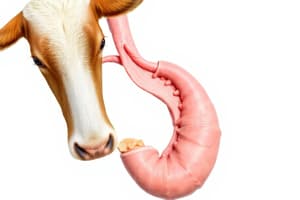Podcast
Questions and Answers
What is the term for the process by which ruminants re-chew their food?
What is the term for the process by which ruminants re-chew their food?
Rumination
Identify a primary cause of ruminant acidosis in cattle.
Identify a primary cause of ruminant acidosis in cattle.
Ingestion of large amounts of fermentable, carbohydrate-rich feeds.
What symptoms indicate the presence of bloat in ruminants?
What symptoms indicate the presence of bloat in ruminants?
Buildup of gas in the rumen.
What management practices can prevent acidosis in cattle?
What management practices can prevent acidosis in cattle?
Which natural process is responsible for gas production in the rumen?
Which natural process is responsible for gas production in the rumen?
What is a significant consequence when gas is not released properly in ruminants?
What is a significant consequence when gas is not released properly in ruminants?
What metabolic disease is caused by excessive acid accumulation in the rumen?
What metabolic disease is caused by excessive acid accumulation in the rumen?
Describe the relationship between ruminants and microbes during digestion.
Describe the relationship between ruminants and microbes during digestion.
What role does hydrochloric acid (HCl) play in the ruminant stomach?
What role does hydrochloric acid (HCl) play in the ruminant stomach?
How does the acidic pH of the ruminant stomach influence pepsinogen?
How does the acidic pH of the ruminant stomach influence pepsinogen?
What role does adequate fiber play in the digestion process of ruminants?
What role does adequate fiber play in the digestion process of ruminants?
Explain the significance of the reticulum in ruminant digestion.
Explain the significance of the reticulum in ruminant digestion.
What is the primary function of the omasum in ruminants?
What is the primary function of the omasum in ruminants?
Differentiate the dental formula of ruminants from that of monogastrics.
Differentiate the dental formula of ruminants from that of monogastrics.
How do microorganisms contribute to the digestion of ruminant animals?
How do microorganisms contribute to the digestion of ruminant animals?
Describe the role of saliva in the digestive process of cattle.
Describe the role of saliva in the digestive process of cattle.
What structural feature differentiates ruminant digestive systems from monogastrics?
What structural feature differentiates ruminant digestive systems from monogastrics?
Discuss the benefits of flat premolars in ruminants.
Discuss the benefits of flat premolars in ruminants.
What components are primarily absorbed in the small intestine of ruminants?
What components are primarily absorbed in the small intestine of ruminants?
Why is anaerobic digestion particularly important for ruminants?
Why is anaerobic digestion particularly important for ruminants?
Flashcards are hidden until you start studying
Study Notes
Ruminant Digestion Process
- Ruminants chew their food multiple times through a process called rumination, involving regurgitation and re-chewing.
- The ruminant stomach has four compartments: rumen, reticulum, omasum, and abomasum.
Ruminant Acidosis and Prevention
- Ruminant acidosis is typically caused by consuming large amounts of fermentable, carbohydrate-rich feeds.
- Correct feeding and herd management practices can help prevent acidosis in cattle.
Bloat in Ruminants
- Primary symptom of bloat is the buildup of gas in the rumen, which can lead to discomfort and health issues if not released effectively.
Fermentation and Gas Production
- Gas production in the rumen is a natural byproduct of the fermentation process performed by symbiotic microbes.
- Improper gas release can result in bloat, causing discomfort and potential health complications.
Acid-Base Balance in the Rumen
- Excessive acid in the rumen leads to ruminant acidosis, a significant metabolic disease.
- The stomach's acidic environment, maintained by hydrochloric acid (HCl), promotes protein digestion by activating pepsinogen into pepsin.
Importance of Saliva and Gastric Juices
- Saliva in cattle serves as a lubricant, aids chewing and swallowing, and initiates food breakdown.
- Gastric juices, which include HCl and pepsinogen, facilitate the chemical and physical breakdown of food.
Nutrient Absorption and Digestive Efficiency
- The small intestine absorbs amino acids, glucose, vitamins, and minerals from digested food.
- Fiber supplementation is crucial in ruminant diets as it promotes movement and peristalsis in the rumen.
Dietary Differences
- Ruminants primarily consume fibrous plant materials, while monogastrics focus on concentrate rations.
- Unique dental formulas distinguish ruminants (0 I 0 C 3 PM 3 M) from monogastrics (3 I 1 C 4 PM 3 M).
Role of Microorganisms
- Microorganisms play a vital role in digesting ruminants by fermenting food, breaking down cellulose, and aiding nutrient absorption.
- Anaerobic digestion allows efficient fermentation and breakdown of plant materials, maximizing nutrient uptake.
Function of Stomach Compartments
- The reticulum assists in collecting smaller particles and promotes microbial fermentation.
- The omasum is crucial for absorbing water and nutrients from digested food.
Dentition and Teeth Functionality
- Ruminants possess incisors for cutting, canines for tearing, and molars for grinding, enhancing their ability to process fibrous materials.
- Flat premolars are specifically adapted for effective grinding of plant materials, essential in breaking down fibrous cell walls.
Dietary Adaptation to Grains
- When transitioning to high grain diets, the rumen adapts to enhance digestibility and efficiency in processing grains.
Studying That Suits You
Use AI to generate personalized quizzes and flashcards to suit your learning preferences.




